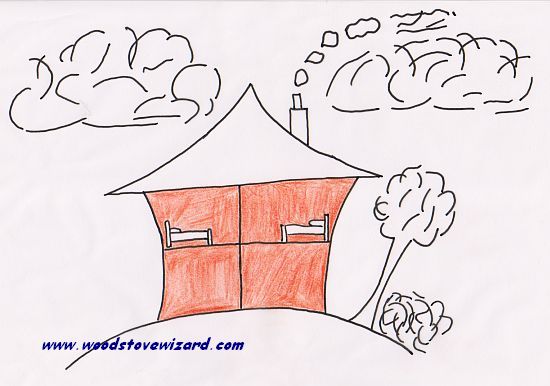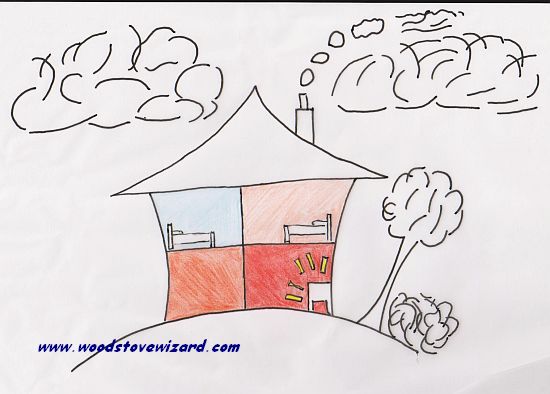Home Heating with a wood stove
Home heating with wood is a tricky business. Unless you already have a wood stove you are unlikely to have spent much time thinking about how heat moves around your home. Traditional home heating systems, such as hydronic central heating, consist of distributed thermostatically controlled radiators in each room. The temperature remains comfortable in each room throughout the day.

A modern, centrally heated house guarantees even heat to every room - whether the room is used or not - but is expensive to run!
Unfortunately this pattern breaks down when you start firing your home with a wood stove. Typically these are installed in a central living location, lit in the evening for a few hours and then left to go out overnight. Gone is the comfortable thermostatically controlled temperature. Instead air temperatures in the building can swing wildly from too hot in the sitting room with the fire going, to too cold in the extremities of the house, and too cold everywhere as the temperature falls rapidly when the fire is out.
Some owners of wood stoves end up realising that parts of their home are 'colder' when using the stove and end up reverting to the fossil fuel burning central heating system for the bulk of their heating. As a result the wood stove ends up being relegated to novelty uses at Christmas or family gatherings and makes little overall impact to the bills.
Fortunately with a bit of thought and knowledge about how warm air moves through your home you can significantly improve on this 'natural' state.
How heat moves...
Heat moves primarily through three different mechanisms
- Conduction - passing through a solid material such as brick walls (slowly)
- Convection - warm air circulates through the building from room to room (depends on building configuration, air temperature etc... )
- Radiation - passing through the air as infrared light (objects must be HOT for this to be significant)
Short of ripping out your interior walls and replacing them with conductive steel there is little we can do to encourage conduction.
You can boost radiant heat transfer by getting your stove hotter - but if you over heat your stove you reduce its working lifespan as the interior parts overheat and are damaged so we probably can rule out this one.
Finally we get to convection which we can have some control over. If we understand how warm air moves through the building we can encourage it to move where we want it to be, either by speeding up or restricting convection in different parts of the building.
Hot air rises...
We've probably all seen a hot air balloon at some point - the obvious demonstration of hot air rising - but the true picture is a little more complicated than that. Indoors hot air doesn't just rise, it circulates within rooms, corridors and from floor to floor.
- Air near your fireplace is heated up and expands
- As it expands it becomes less dense (lighter) than the cooler air around it and rises upwards
- Cold air circulates to fill the gap, is heated by the fire and also rises
- Over all the air in the room is warmed as it circulates past the fire.
The challenge is to encourage air circulation from room to room so that warm air spreads evenly through the whole building, rather than just remaining trapped near the stove.
How to improve overall air circulation...
Here are some ideas for how to encourage heat circulation within your house.
- Decide which rooms you want the heat to go to and open and close doors accordingly
Does the upstairs spare bedroom need heating if it isn't being used? Could you put an extra duvet on your bed and have your bedroom cooler? Are you using the study at the moment? Closing doors to rooms that don't need the heat encourages circulation to the rooms that do.
- If one isolated room needs heating, find an alternative rather than heat all the space in between
My grandparents study is on the ground floor in an unheated part of the house. The area is drafty and cold except for a small electric fan heater that is used just when the room is in use. This is much better than trying to heat all of the space between the study and the living areas.
- Encourage convection by using fans
Even a small fan can make a significant difference to heat circulation. An adapted PC fan in the doorway between our sitting room and hall drastically increases convection from space to space.
- Smoke test to see where the heat is going
Air circulates naturally through your house and a lit fire encourages this. Smoke lets you see the air flows within rooms, between rooms, along passage ways etc... If you are a smoker there is an obvious solution - if not you could light and extinguish a piece of newspaper and watch the smoke as your move it around. (NB Hot air moves through the top of door ways, cold through the bottom)
- Fireplaces and wood stoves of all types send heated air up your chimney and cold air is drawn into the house from outside to compensate - find out where it enters your home
You can then consider draft proofing if it is meant to be a 'warm' room or not if it is a cold room.
Considering some of these points can help turn your existing wood stove into valuable part of your home heating strategy, as well as help you plan positions and sizes of new stove installations.
If you are trying to figure out how to get lower bills for home heating you might visit our page on the effect central heating has had on our perceptions and habits. This simple bit of information could be a big step towards lower heating bills!

